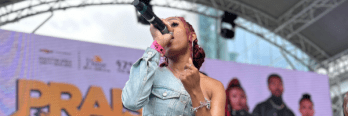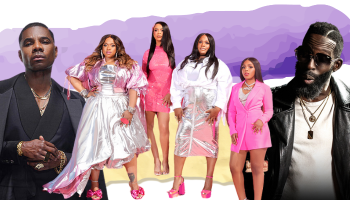“Sexy laaaadyyy! Give me your number giiiiirl” If you just sang these lyrics out loud, congrats you know at least one Go-Go song but do you know how this game-changing music has gone beyond being just a genre? Do you truly understand why DC can’t be muted? Can you tell me who said, “Chuck Baby don’t give a what”? Welp, “Wind Me Up Chuck” and get ready to Bust Loose or beat ya feet to the history of Go-Go music; how it started vs how it’s going.
Go originated in Washington, D.C., during the 1970s. Although bands, such as the Young Senators and Aggression were involved in the early evolution of the genre, singer-guitarist Chuck Brown credited and titled as the God-Father of Go-Go. His genius developed the foundations on which this sound and culture continue to stand today. Brown, a staple in the DMV music scene with his band the Soul Searchers starting back in 1966, developed a relaxed style of funk, laced with Afro Caribbean rhythms and instruments and performed non-stop. Yes, they made sure the music kept going and going and going, hints the name Go-Go, in order to keep people on the dance floor and be absorbed in the full experience. Watch the clip below from an interview in 2009, where Chuck Brown explains the evolution of Go-Go and how he was rapping before rappers were even thought about
Once this musical formula was figured out and received amazing reception, James Funk started Rare Essence following Chuck Brown’s model. The movement continued to grow and cross boundaries. A 1960s cover group with roots in Top-40 music called Trouble Band adopted the Go-Go beat and changed their name to Trouble Funk in the late 1970s. Experience Unlimited aka EU, formed in 1970, and followed Rare Essence into the Go-Go fold by the end of the decade. EU exploded worldwide when their hit song “Da Butt” left a lasting impression on the culture in Spike Lee’s notorious film “School Daze” and in 2019, DC native Regina Hall paid tribute to the accomplishments of the pioneers of Go-Go music with her opening performance as the host of the BET awards which was seen by millions.
But this wasn’t the first time Go-Go reached audiences in this capacity. Back in 1978, Chuck Brown and the Soul Searchers released their “Bustin’ Loose” single and it rocketed to the #1 spot on Billboard’s R&B chart and remained #1 during February and in March of 1979, it reached #34 on the Pop chart. In the 1980s Go-Go flirted with outside success with the release of Trouble Funk’s “Pump Me Up” and the relatively negative but national press related to the Chris Blackwell/Island Film “Good to Go.” The Junk Yard Band enjoyed regional success with its 1986 release, “The Word” and “Sardines,” which came out on Def Jam. Along with the success of EU’s “Da Butt”, as mentioned earlier, in the decade between 1979-1989, Go Go received its widest national exposure.
The momentum hasn’t slowed down. Several other important groups, most notably Backyard Band and the North East Groovers, came onto the scene during the 1990s. During these past few decades, groups such as Familiar Faces, Lissen Band, UCB, CCB, TCB, Mambo Sauce, and New Impressionz emerged. One
of my favorite groups, Be’ La Dona, is the perfect display of women’s excellence. In a genre mainly ran by men, this all-women band is definitely one of a kind.
Women have more commonly dominated in the lead mic position in Go-Go and Tiffany “Sweet Thang” White of Backyard Band has held her own. In this interview produced by ANJPR and myself, Sweet Thang describes her journey before the success of BYB’s hit cover of Adele’s “Hello.”
Radio One D.C. and TV One, whose headquarters is in the DMV, have continued to highlight the accomplishments within this world of Go-Go throughout the community and currently continue to spotlight Go-Go on their airways. Take a look at their recent town hall held by TV One discussing the history and legacy of Go-Go music, how the music serves as a platform for African Americans to address issues such as class struggles, gentrification, and the music’s impact on black culture.
Today, “beat ya feet” and the “bounce beat” are the most significant trends in Go Go. Wale who is a DMV native broke into the mainstream in 2008 with his Go-Go influenced single Pretty Girls. As he gained fans from all over the world, Wale made sure his foundation in Go-Go was felt throughout his debut album and each body of work since then. To kick off each new year, Wale holds his “Wale and Friends” concert at the Fillmore in Silver Spring Maryland, highlighting artists from the DMV, who may not use Go-Go in their music but definitely have a foundation in it.
As Wale does annually, we’ve seen before our eyes the power music has to bring people together. To honor the amazing Donnie Simpson on his induction into the Radio Hall of Fame, Go-Go artists came together to perform the song “I Wanna Thank You”. These collaborations were definitely high because at the end of the day it’s all about bringing our community together. In 2019 our very own Angie Ange had a monumental moment live on-air bringing together Big G and Rapper of the W.H.A.T. to set aside their differences.
Again, the theme of together is embedded within our culture and music so when the world shut down due to COVID-19, the Go-Go community quickly adapted. Many bands chose to perform their shows virtually to remind everyone to keep their hopes up while staying home and safe because as we know to be a mantra in life, “It don’t mean a thing if it don’t got that Go-Go swing”
For The Culture Podcast: The History Of Go-Go was originally published on blackamericaweb.com













